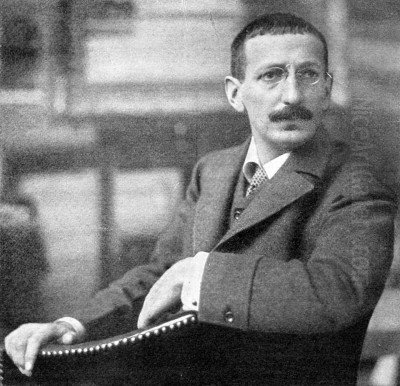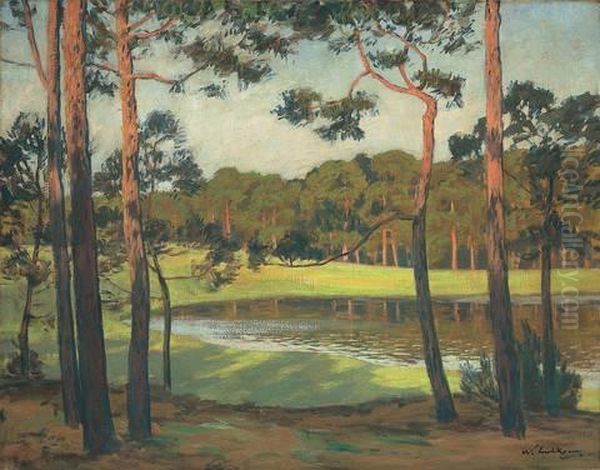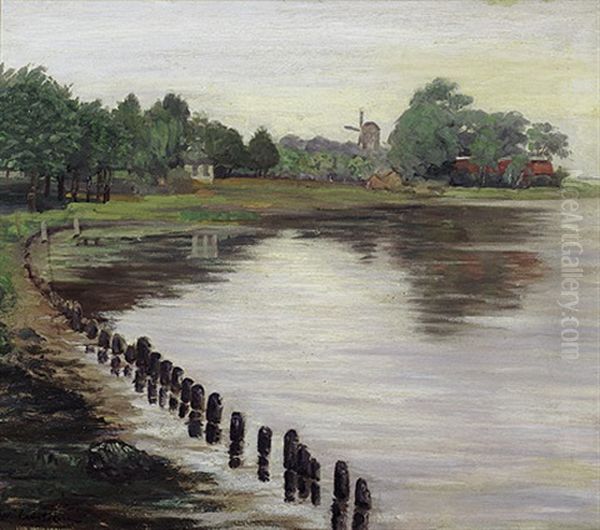
Walter Leistikow stands as a pivotal figure in the transition of German art at the turn of the 20th century. A landscape painter, graphic artist, and influential organizer, he was instrumental in challenging the conservative art establishment of Imperial Berlin and fostering the rise of modernism. His distinctive, often melancholic depictions of the Brandenburg landscape, combined with his crucial role in founding the Berlin Secession, cemented his legacy as a key proponent of new artistic directions in Germany.
Early Life and Artistic Formation
Walter Rudolf Leistikow was born on October 25, 1865, in Bromberg, Prussia (now Bydgoszcz, Poland). His father was a pharmacist and merchant with business interests extending to Russia, while his mother came from a Jewish background. Growing up in a cultured environment, the young Leistikow showed an early inclination towards the arts. At the age of seventeen, having decided to pursue a career as a painter, he made the significant move to the bustling imperial capital, Berlin, in 1883.
His initial foray into formal art education proved discouraging. Leistikow enrolled at the prestigious Royal Academy of Fine Arts (Königlich Preußische Akademie der Künste). However, his time there was short-lived. After only six months, he was dismissed by Anton von Werner, the influential director of the Academy and a staunch defender of academic tradition, allegedly for a "lack of talent." This early rejection, rather than deterring him, seemed to strengthen his resolve.
Undeterred by the Academy's verdict, Leistikow sought private instruction. He first studied under the landscape painter Hermann Eschke from 1883 to 1885. Subsequently, from 1885 to 1887, he became a pupil of the renowned Norwegian landscape painter Hans Gude, who was then teaching in Berlin. Gude, known for his dramatic coastal scenes and mastery of light, exerted a noticeable influence on Leistikow's early development, particularly in his handling of atmosphere and natural detail. Leistikow completed his formal studies under Gude in 1887.
Emergence as an Artist and Early Style

Leistikow began to establish himself in the Berlin art scene. A significant early success came in 1886 when he exhibited his work at the official Berlin Salon, demonstrating that despite the Academy's rejection, his talent was gaining recognition. His early works often depicted coastal scenes, reflecting the influence of Eschke and Gude, as well as travels to the Baltic Sea coast.
A key painting from this period is Brickworks near Eckernförde (Ziegelei bei Eckernförde), completed in 1887. This work already hints at Leistikow's developing interest in capturing specific light conditions and the atmosphere of a working landscape, moving beyond purely picturesque representation. It showcases his growing technical skill and his engagement with the naturalistic trends prevalent at the time, yet with a personal touch in the composition and mood.
During the late 1880s and early 1890s, Leistikow increasingly turned his attention to the landscapes surrounding Berlin, particularly the forests and lakes of the Brandenburg March. This region, with its pine forests, sandy soil, and numerous lakes like the Grunewaldsee and Schlachtensee, would become his most enduring subject matter. He developed a deep connection to this landscape, finding in its quiet, often somber beauty a perfect vehicle for his artistic temperament.
From 1890 to 1897, Leistikow maintained a studio at Lützowstraße 82 in Berlin's Tiergarten district, an area known for its artist studios. During this time, he also became involved in artists' associations, serving as a representative for the Free Association of Landscape Painters of Prussia, indicating his growing stature within the Berlin art community.
The Road to Secession: Die XI
The official art scene in Berlin during the late 19th century was dominated by the conservative tastes favored by Emperor Wilhelm II and upheld by institutions like the Royal Academy under Anton von Werner. The annual Great Berlin Art Exhibition (Große Berliner Kunstausstellung), controlled by the establishment-aligned Association of Berlin Artists, often excluded more progressive or stylistically innovative works.
Frustration with this restrictive environment led a group of forward-thinking artists to seek alternative platforms. In 1892, Walter Leistikow, alongside fellow artist Max Liebermann and others including Ludwig von Hofmann and Franz Skarbina, founded the "Vereinigung der XI" (Association of the Eleven), commonly known as "Die XI". This group aimed to organize independent exhibitions showcasing works that might not find favor with the official Salon jury.

Die XI represented a significant early challenge to the artistic status quo in Berlin. While not as radical as the later Secession, it provided a crucial venue for artists exploring Impressionist and Naturalist tendencies, offering the Berlin public a glimpse of art beyond the officially sanctioned academic styles. Leistikow was a driving force within this group, demonstrating early on his organizational skills and his commitment to promoting artistic freedom. The exhibitions of Die XI helped pave the way for the larger rupture that was to come.
Founding the Berlin Secession
The simmering conflict between progressive artists and the conservative art establishment reached a boiling point in 1898. Leistikow submitted a large landscape painting, likely a depiction of the Grunewaldsee, to the Great Berlin Art Exhibition. The jury, headed by Anton von Werner, rejected the painting. Accounts suggest the rejection was due to its perceived lack of "naturalness," with specific criticism aimed at Leistikow's stylized rendering and perhaps his use of color – the anecdote of his trees being "painted blue" likely stems from this or similar incidents, highlighting his departure from strict academic realism.
This rejection proved to be the catalyst for a major schism in the Berlin art world. Outraged by the jury's decision and the ongoing dominance of the conservative faction, Leistikow, Max Liebermann, and the influential art dealer Paul Cassirer spearheaded the formation of the Berlin Secession (Berliner Secession). Officially founded in 1898, the Secession declared its independence from the Association of Berlin Artists and the Great Berlin Art Exhibition.
Leistikow was not only a founding member but also a key organizer and board member of the Berlin Secession. Max Liebermann served as its first president. The Secession aimed to provide a platform for modern art, free from the constraints of the official jury system. It embraced a wide range of styles, including German Impressionism (represented by Liebermann, Max Slevogt, and Lovis Corinth), Symbolism, and Jugendstil (Art Nouveau), and it also exhibited works by international artists like Edvard Munch, Auguste Rodin, and the French Impressionists.
The founding of the Berlin Secession was a landmark event in German art history. It signaled a definitive break with the past and established Berlin as a major center for modern art in Germany, rivaling Munich. Leistikow's role in instigating and organizing this movement was crucial, marking him as a central figure in the fight for artistic modernity in the German capital.
Leistikow's Artistic Style: Melancholy Landscapes and Decorative Tendencies
Walter Leistikow's mature artistic style is characterized by a unique blend of influences and a deeply personal vision, primarily expressed through landscape painting. While often associated with German Impressionism, his work transcends easy categorization, incorporating strong elements of Symbolism and Jugendstil. His primary subject remained the landscape around Berlin – the Grunewald forest, the Havel river, and the numerous lakes like Schlachtensee and Wannsee.
He was less interested in the fleeting effects of light in the manner of French Impressionists like Claude Monet or Camille Pissarro, although their influence is discernible in his brushwork and attention to atmosphere. Instead, Leistikow focused on capturing the underlying mood and structure of the landscape, often imbuing his scenes with a sense of melancholy, stillness, and introspection. His paintings frequently depict twilight hours, misty mornings, or the quiet solitude of the forest, emphasizing simplified forms and strong compositional lines.
A key characteristic of Leistikow's style is its decorative quality, linking him to the Jugendstil movement. He often employed flattened perspectives, stylized silhouettes of trees, and harmonious, sometimes non-naturalistic color palettes. The rhythmic arrangement of forms, particularly the vertical lines of pine trees against the horizontal expanse of water or sky, creates a distinct decorative pattern. This tendency is evident in his famous depictions of the Grunewaldsee, where the dark, almost graphic shapes of the pines contrast with the luminous water and sky.
His use of color could be bold and expressive, contributing significantly to the emotional tone of his works. The infamous "blue trees" comment, while possibly exaggerated, points to his willingness to prioritize artistic expression and decorative effect over literal representation. This approach connects him to Symbolist painters who sought to convey inner states and ideas rather than merely depicting external reality, and shows an affinity with artists like Edvard Munch, whose work was exhibited by the Secession and known for its emotional intensity.
Mature Works, Etchings, and Applied Arts
Throughout the late 1890s and the early 1900s, Leistikow produced his most characteristic and celebrated works. Paintings such as Grunewaldsee (multiple versions exist, often depicting the lake at sunset or dusk), Abendstimmung am Schlachtensee (Evening Mood at Schlachtensee), and numerous other Märkische Seenlandschaft (Brandenburg Lake Landscapes) solidified his reputation as the preeminent painter of the Berlin environs. These works masterfully balance observation of nature with stylized composition and evocative mood.
Beyond oil painting, Leistikow was also a skilled graphic artist, particularly known for his etchings and lithographs. These prints often revisited his favorite landscape motifs, translating the atmospheric qualities of his paintings into the linear medium of printmaking. His graphic work further emphasized the decorative aspects of his style, with strong contrasts and simplified forms.
Leistikow also embraced the Jugendstil ideal of integrating art into everyday life by working in the applied arts. He created designs for textiles, carpets, furniture, and even entire room interiors. This aspect of his work highlights his connection to the broader Arts and Crafts and Art Nouveau movements, which sought to break down the hierarchy between fine and applied arts and to bring aesthetic quality to functional objects. His decorative designs often featured stylized natural forms, consistent with his landscape paintings.
The color lithograph Villa am See (Villa by the Lake), sometimes dated to 1913 (posthumously published or based on an earlier design), exemplifies his later graphic style and continued engagement with the Brandenburg landscape, rendered with the characteristic simplification and atmospheric color of his mature period.
Leistikow as Organizer, Networker, and Advocate
Leistikow's importance extends beyond his own artistic production. He was a tireless organizer and networker, playing a vital role in the institutional landscape of modern art in Germany. Within the Berlin Secession, he served on the board and the jury, influencing the selection of artists for their influential exhibitions. These exhibitions introduced the Berlin public not only to German modernists but also to international avant-garde figures.
He was known for his ability to recognize and support talent. A notable example is his relationship with Lovis Corinth. Leistikow encouraged Corinth to move from Munich to Berlin and actively promoted his work, helping him gain entry into the Secession and the Berlin art market. This support was crucial for Corinth, who became one of the leading figures of German Impressionism alongside Max Liebermann and Max Slevogt.
Leistikow's organizational efforts continued with the founding of the Deutscher Künstlerbund (Association of German Artists) in 1903. Initiated by Count Harry Graf Kessler, a prominent patron of modern art, the Künstlerbund aimed to unite progressive artists from across Germany, transcending regional boundaries and Secession groups (like those in Munich and Vienna). Leistikow was among the founding members, alongside artists like Max Klinger and Liebermann, further demonstrating his commitment to creating supportive structures for modern artists nationwide.
His network included many of the leading artistic and cultural figures of the era. Besides Liebermann, Corinth, Slevogt, Cassirer, Kessler, and Hofmann, he interacted with artists associated with the Secession such as Lesser Ury, Käthe Kollwitz, Ernst Barlach, and briefly, Emil Nolde, who represented the emerging Expressionist generation. His early studies connected him to Eschke and Gude, and his style showed awareness of international figures like Monet, Pissarro, Van Gogh, and Munch. His opposition placed him against figures like Anton von Werner.
Later Years, Tragic End, and Legacy
In recognition of his artistic achievements and his contributions to the Berlin art scene, Walter Leistikow was awarded the title of Professor in 1907. He continued to paint and remained active in the Berlin Secession, which had become the dominant force for modern art in the city. His landscapes remained highly sought after, capturing a specific sense of place and time that resonated with many.
However, Leistikow's later years were overshadowed by personal tragedy. He had contracted syphilis, an incurable disease at the time, which progressively worsened, causing him significant physical and mental suffering. Faced with the debilitating effects of the advanced stages of the illness, Walter Leistikow took his own life on July 24, 1908, at his home near the Schlachtensee in Berlin, the very landscape he had so often painted. He was only 42 years old.
Despite his relatively short life, Walter Leistikow left a significant legacy. As a painter, he created a distinctive and influential body of work, defining the artistic image of the Brandenburg landscape and skillfully blending Impressionist, Symbolist, and Jugendstil elements. His melancholic, atmospheric scenes remain iconic representations of the region.
Perhaps even more importantly, his role as a co-founder and driving force behind the Berlin Secession was crucial in breaking the hold of academic conservatism and establishing modern art in the German capital. The Secession provided a vital platform for German Impressionism and paved the way for the subsequent rise of Expressionism. Artists like Ernst Ludwig Kirchner, Karl Schmidt-Rottluff, and others associated with Die Brücke would soon take German modernism in even more radical directions, building on the freedoms won by Leistikow's generation.
Today, Walter Leistikow's works are held in major German museums, including the Alte Nationalgalerie and the Bröhan Museum in Berlin, as well as other public and private collections. He is remembered as a sensitive painter of the German landscape and a key figure in the cultural ferment of turn-of-the-century Berlin, an artist whose life and work were inextricably linked to the dawn of modernism in Germany.
Conclusion
Walter Leistikow was more than just a painter of moody landscapes; he was a catalyst for change in the German art world. From his early struggles against academic rejection to his pivotal role in founding Die XI and the Berlin Secession, he consistently championed artistic innovation and freedom. His paintings, particularly his evocative depictions of the lakes and forests around Berlin, offer a unique synthesis of natural observation, Symbolist feeling, and Jugendstil design. Though his life ended tragically and prematurely, Leistikow's contributions as both an artist and an organizer had a lasting impact, helping to shape the course of modern art in Germany and securing his place as a significant figure in art history.